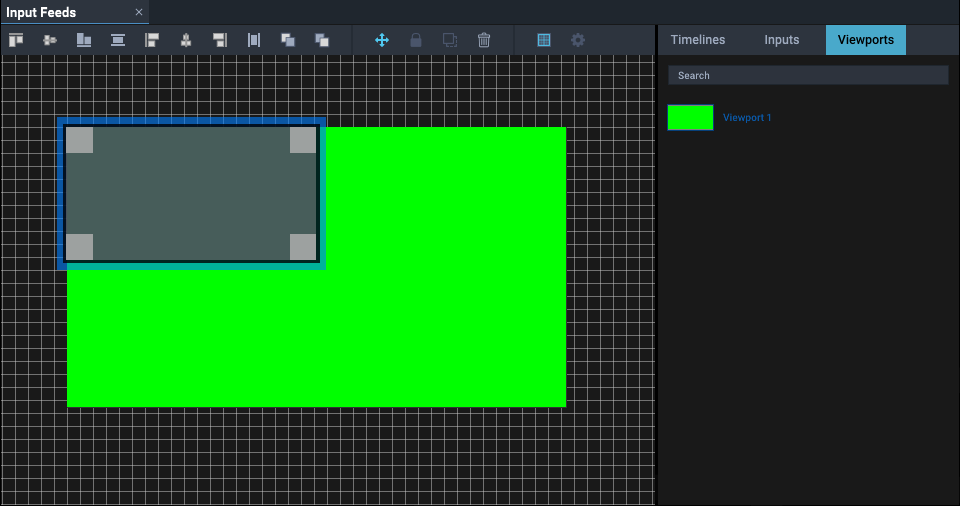The input Feeds panel brings input streams and/or timeline framebuffers into play. From these we can be selective as to which pixels will get passed to outputs. The Input Feeds panel is used to gather all types of inputs, and once arranged the panel can be closed and recalled as required.
Populate the Input Feeds Panel
Drag any input stream or timeline framebuffer from the Project tab of the Project Panel into the Input Feeds panel. This represents the maximum resolution to be rendered from the input and adds the input into the Project tree. In the case of a timeline input, this creates an ‘Input > Timeline Framebuffer’. This input is the rectangle you see in the Input Feeds panel: it is all the pixels coming in from the chosen feed.
Inputs can be left-mouse dragged to reposition them in the panel, or the whole panel grid panned in the same way. The mouse wheel will zoom the whole panel in and out.
Inputs can be resized to a relative resolution using the size properties.
Timeline feed properties
Name
Name each input for easy identification, especially if also renaming your timelines, so they correspond. Make sure you can easily relate your timeline input names to your framebuffer names. Note that timelines are listed in order of addition, not alphabetically.
Position
X,Y origin (top-left corner position) of this frame buffer in the panel. An origin of 0,0 is best practice for the first. Input viewports are positioned relative to input positions.
Render Order
As required, enter the z-order of multiple timeline framebuffers.
Size
Pixel width and height of the input.
Input feed properties
Name
Name each input for easy identification, especially if also renaming your timelines, so they correspond. Make sure you can easily relate your timeline input names to your framebuffer names. Note that timelines are listed in order of addition, not alphabetically.
NDI Source Name
Enter the name of the NDI stream.
Persistent
Check this to keep the source in cache, uncheck to save memory use.
Position
X,Y origin (top-left corner position) of this frame buffer in the panel. An origin of 0,0 is best practice for the first. Input viewports are positioned relative to input positions.
Render Mode
Select from GUI, Server or both, as the whether this feed will be rendered in the user interface as an independent feed, or (where a timeline asset) in the actual server output to display.
Size
Pixel width and height of the input.
Viewports in Input Feeds
Viewports select those pixel areas of an input (e.g. a timeline frame buffer, camera feed, NDI stream) that you want to bring onto your outputs.
Drag a viewport from the Resources panel onto the input in the Input Feeds panel. The first viewport will snap to the origin of the input it is dropped over, and fill it. It will show in the Project panel under Input Feeds as a child of its input:
Move and resize it as required, either by dragging or by precisely entering position and dimensions in its properties. This will display any current input that lies within the bounds of the viewport. This viewport belongs to this input, and cannot be dragged onto a different input. Viewports may overlap, but can only be ‘attached’ to an input when introduced into uncovered space on that input.
Once created, viewports are added as thumbnails to the input and output feeds panels under ‘Viewports’, from where they can also be selected and dragged.

This is the point at which you can return to the Output Feeds panel to position and scale the captured pixel area on the canvas.
Viewport properties
Name
Name each viewport for easy identification. This might be an individual stream name, or a position reference.
Position (input)
X,Y origin (top-left corner position) of this viewport relative to the input feed it is laid over.
Size (input)
Pixel width and height of the viewport input area.
Note: viewports are added by default at the resolution and position of the input to which they are applied.
Page edited [d/m/y]: 18/07/2024
